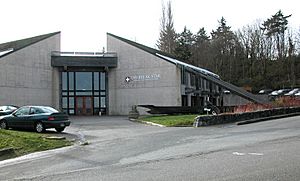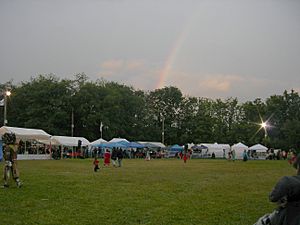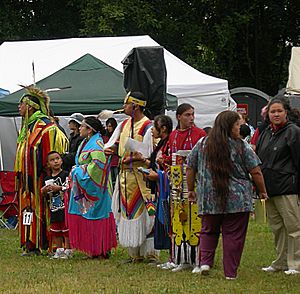Daybreak Star Cultural Center facts for kids
| Location | Seattle, Washington, United States |
|---|
The Daybreak Star Indian Cultural Center is a special place for Native Americans in Seattle, Washington. Its main goal is to be a home base for Native American people living in the Seattle area. It sits on 20 acres of land in Discovery Park, a large park in Seattle's Magnolia neighborhood.
The center came to be because of the strong efforts of Bernie Whitebear and other Native Americans. They took action in 1970 by occupying the land. This land used to be part of Fort Lawton, a military base that the U.S. government no longer needed. The Native American groups believed they had a right to the land based on old treaties from 1865. These treaties said that extra military lands should go back to their original owners.
The main building, finished in 1977, has a modern design that also includes many features from traditional Northwest Native architecture. In 2004, there were plans to add more buildings called the People's Lodge. This was Bernie Whitebear's last big dream before he passed away in 2000. However, in 2006, the center decided to put off building the new complex because they didn't have enough money.
Daybreak Star is a very important place for Native American culture in its region. It hosts many events and activities. It is used for conferences, pow wows (traditional Native American gatherings), and even has a Head Start school for young children. The center also has an art gallery. Its permanent art collection includes large artworks by and about Native Americans. One famous piece is Blue Jay, a huge sculpture by Lawney Reyes, who was Bernie Whitebear's brother. This sculpture is 30 feet wide and 12 feet high!
Next to the center building, there is a garden called the Bernie Whitebear Memorial Ethnobotanical Garden. It honors Bernie Whitebear and features plants important to Native American traditions.
How the Center Started
In 1970, the U.S. government was looking at its military bases. They decided that a large part of Fort Lawton, located on Puget Sound, was no longer needed. Two U.S. Senators from Washington, Henry M. "Scoop" Jackson and Warren G. Magnuson, helped change a law. This change made it easier and cheaper for groups other than real estate developers to get surplus government land. The land would first go to the city, but its future use was not yet decided.
During this time, many Native Americans living in Seattle wanted to have their own land base within the city. About 25,000 Native Americans from different tribes live in the Seattle area. A group formed, calling themselves Kinatechitapi, which means "All Indians" in the Blackfoot language. This name was inspired by the Indians of All Tribes (IAT) group, who were occupying Alcatraz Island in San Francisco Bay. Joe DeLaCruz, a leader of the Quinault tribe, reached out to every tribe in Washington State. He wanted their support to gain land in Seattle.
The Kinatechitapi group tried to talk with the City of Seattle about the Fort Lawton land before it was given to the city. But the city, led by Mayor Wes Uhlman, refused to talk until they owned the land. They told the group to contact the Bureau of Indian Affairs (BIA). Bernie Whitebear later wrote that this showed the city didn't understand that the BIA usually didn't help Native Americans living in cities. The city also thought that a small Indian Center in a former church downtown was enough for Seattle's Native Americans. Also, a powerful local group, the Magnolia Community Club, did not want Native Americans on the Fort Lawton land.
The Kinatechitapi members had different ideas. Some wanted to take direct action, while others preferred to wait and negotiate with the city. Pearl Warren, who started the American Indian Women's Service League, was worried that strong actions would make the city reduce services for urban Native Americans. The group agreed that those who took more extreme action would not use the name Kinatechitapi. Later, Joyce Reyes, who supported direct action, became the new president of the Service League. Soon, all major Native American organizations in Seattle agreed to take action.
Taking Direct Action
The group that wanted to take direct action was led by Bernie Whitebear. They called themselves the "American Indian Fort Lawton Occupation Forces." Bob Satiacum was also a key leader. Some of the Indians of All Tribes from Alcatraz came to Seattle to help, including Richard Oakes, who led the Alcatraz occupation. Other activists came from Canada. Grace Thorpe, the daughter of famous athlete Jim Thorpe, also came to support them. Local activists Ella Aquino and Ramona Bennett helped plan the occupation.
The group planned to enter the military base from two directions. One group would climb the bluffs from Elliott Bay, and another would climb the fence near the Lawton Wood community. The group promised to remain peaceful during their action.
At the same time, Native American soldiers and others were protesting at Fort Lewis near Tacoma. They connected Native rights with their opposition to the Vietnam War. Because of this, actress Jane Fonda came to Seattle when the Fort Lawton occupation happened. Bernie Whitebear said that her presence "captured the imagination of the world press." He felt that her presence helped the Native American movement gain important attention and respect.
On the evening of March 7, 1970, the plans for the occupation were announced at a pow-wow. The next day, March 8, 1970, about 100 Native Americans and their supporters faced military police at the fort. About 500 more supporters held a legal protest outside the gates. Some of the people entering the base reached the chapel, but the military police quickly stopped most of the invasion. Some people did not remain peaceful, especially when the military police were very aggressive. The military police, with help from regular Army troops and Seattle Police, first put the people in the fort's jail. Then they removed them from the fort. The Native American activists then set up a tipi camp outside the fort. Mayor Uhlman and Senator Jackson held a press conference about the Fort Lawton land, promising it would become a city park. They did not mention the Native American action.
United Indians of All Tribes Foundation
The Native American groups then organized as the United Indians of All Tribes Foundation (UIATF), with Bernie Whitebear as their leader. They used many different ways to gain support. These included talking to politicians, occupying land, and having famous people visit. For three months, activists kept trying to enter the fort. The Army put up barbed wire, brought in troops from Fort Lewis, and dug trenches to stop them.
By this time, more than 40 non-Native American organizations in King County supported the Native Americans' efforts. Several leaders, including Bernie Whitebear, spoke before a congressional committee. They also received support from U.S. Congressman Brock Adams from Seattle. Whitebear also worked with Tom McLaughlin from the United States Department of Health, Education, and Welfare.
The UIATF, which had avoided the BIA before, now worked through the National Congress of American Indians. They asked the BIA to stop plans to transfer the Fort Lawton land until their issue with the city was solved. The BIA commissioner, Louis Bruce, did stop the transfer for a while.
When the federal government officially offered the surplus land, UIATF applied to get a part of the fort directly. Thanks to Bernie Whitebear's smart moves, UIATF's application was filed before the city's application for the whole area. The federal General Services Administration, which handled the surplus land, eventually insisted that the City and UIATF create a joint plan for the property.
In November 1971, everyone agreed. The city would give UIATF a 99-year lease on 20 acres of land. This land would become part of Seattle's Discovery Park. The lease could be renewed without new negotiations. The City also gave $600,000 to the American Indian Women's Service League for a social services center.
Bernie Whitebear was then chosen as the CEO of the UIATF. He raised money, including a one million dollar grant from the state. He also oversaw the design and building of the center. His brother, Lawney Reyes, worked with the architects to design the building. It combined traditional Native American elements with a modern style. The Daybreak Star Cultural Center opened in 1977.
Around the same time, Bernie Whitebear was appointed to the Seattle Arts Commission. The UIATF received an $80,000 arts grant for the center. Today, the center also has wireless Internet access for visitors.




